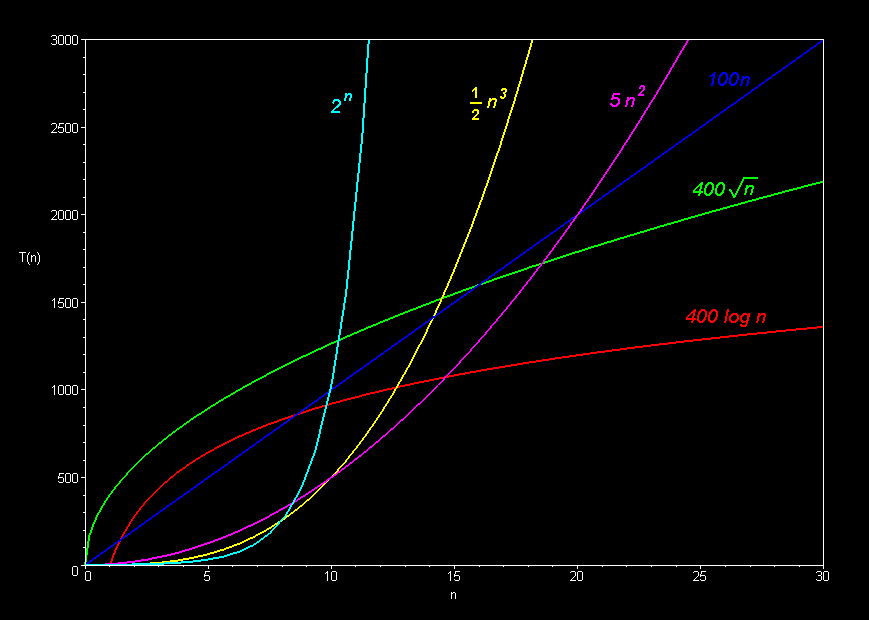算法复杂度分为时间复杂度和空间复杂度,一个好的算法应该具体执行时间短,所需空间少的特点。随着计算机硬件和软件的提升,一个算法的执行时间是算不太精确的。只能依据统计方法对算法进行估算。我们抛开硬件和软件的因素,算法的好坏直接影响程序的运行时间。我们看一下小例子:intvalue=0;//执行了1次for(inti=0;i
【Python学习笔记】Python logging模块的学习
Augenstern K
Pythonpython学习笔记
Pythonlogging模块基础介绍作用与功能基本用法引入模块创建并配置记录器的基本步骤代码演示日志级别日志消息格式用法介绍代码示例日志的输出位置代码示例日志记录的高级功能对日志记录进行过滤和处理在多个模块中使用同一个日志记录器总结当谈到日志记录时,logging库是Python中最常用的工具之一。它提供了许多功能和选项,使开发人员能够灵活地记录和管理应用程序的日志信息。引入logging作为P
Python学习笔记(1)——环境安装与变量
ThinkerChenYi
python学习笔记Python学习笔记
python环境安装-python2还是python3python2只支持到2020年,并且python2和3有不少用法差异。要是刚学完python2不久就发现过时了这就很尴尬了,所以推荐使用python3-安装环境推荐:Anaconda+pychamAnaconda是一个python的科学计算包,python环境,常用模块以及工具都包含在里面,省心省力官网:https://www.anacond
2.25python笔记 高阶编程
13351
@[TOC](2.25学堂在线python学习笔记高阶编程)#高阶编程1.利用二分法查找一个字符是否在某个字符串当中基线条件:当s=''时,返回False当len(s)=1且s==char时返回True当len(s)>1且s[mid]>char时,返回isIn(char,s[:mid])否则当s[mid]1:ifs[mid]>char:print(s)returnisIn(char,s[:mid]
机器学习是什么
MarkHD
机器学习
机器学习是一门跨学科的学科,它使用计算机模拟或实现人类学习行为,通过不断地获取新的知识和技能,重新组织已有的知识结构,从而提高自身的性能。机器学习涉及多个学科,如概率论、统计学、逼近论、凸分析、算法复杂度理论等。机器学习的主要任务是指导计算机从数据中学习,然后利用经验来改善自身的性能,不需要进行明确的编程。机器学习算法会不断进行训练,从大型数据集中发现模式和相关性,然后利用这些模式来预测新数据的结
通过傅里叶变换进行音频变声变调
码农飞飞
音视频处理音视频变声傅里叶变换变调不变速C++
文章目录常见音频变声算法使用Wav库读写音频文件使用pitchShift算法进行音频变调主文件完整代码工程下载地址常见音频变声算法在游戏或者一些特殊场景下为了提高娱乐性或者保护声音的特征,我们会对音频进行变声变调处理。常用的算法包括:1.基于傅里叶变换的频域算法,该类算法的优点是声音连续,不会产生断断续续的声音,缺点是算法复杂度高计算量相对比较大;2.基于时域的插值算法,该类算法的优点是计算简单,
Python学习笔记——逻辑运算符not,and,or
phoebe’
python
运算优先级:not>and>or三个都从左往右解析,区别如下not:返回布尔型(TrueorFalse)>>>not7False>>>not0Trueand:有0(False)则返回0(False),否则返回后一个变量(常数)>>>3and0and10>>>1and2and33>>>Falseand1Falseor:返回第一个不为0(False)的变量(常数)>>>FalseorTrueTrue>
python学习笔记——三目运算符与逻辑运算符
phily123
python学习笔记python
一、三目运算符python中用ifelse来替代其他编程语言的?:三目运算符,并且用法不同。ifa>b:c=aelse:c=bpython中:c=aifa>belsebc语言中:c=a>b?a:b二、逻辑运算符python中逻辑运算符用andornot:20and10#结果是1020or10#结果是200or10#结果是10not10#结果是Falsenot0#结果是Truec语言中逻辑运算符用&
Sparse Principal Component Analysis via Rotation and Truncation
馒头and花卷
SPCArt算法,利用旋转(正交变换更为恰当,因为没有体现出旋转这个过程),交替迭代求解sparsePCA。对以往一些SPCA算法复杂度的总结在这里插入图片描述注:是选取的主成分数目,为迭代次数,为样本维度,为样本数目。本文算法,需要先进行SVD,并未在上表中给出。Notation在这里插入图片描述论文概述就是普通PCA的前个载荷向量(loadings,按照特征值降序排列)也是彼此正交的,张成同一
Python课后习题第十章
水中小船
'''10-1Python学习笔记:在文本编辑器中新建一个文件,写几句话来总结一下你至此学到的Python知识,其中每一行都以“InPythonyoucan”打头。将这个文件命名为learning_python.txt,并将其存储到为完成本章练习而编写的程序所在的目录中。编写一个程序,它读取这个文件,并将你所写的内容打印三次:第一次打印时读取整个文件;第二次打印时遍历文件对象;第三次打印时将各行存
【动态规划】:泰波那契模型_解码方法
stackY、
初阶算法动态规划算法解码方法
朋友们、伙计们,我们又见面了,本专栏是关于各种算法的解析,如果看完之后对你有一定的启发,那么请留下你的三连,祝大家心想事成!C语言专栏:C语言:从入门到精通数据结构专栏:数据结构个人主页:stackY、C++专栏:C++Linux专栏:Linux目录1.题目解析2.算法原理2.1状态表示2.2状态转移方程2.3初始化2.4填表顺序2.5返回值3.代码实现4.算法复杂度5.优化边界情况以及初始化5.
ASM系列六 利用TreeApi 添加和移除类成员
lijingyao8206
jvm动态代理ASM字节码技术TreeAPI
同生成的做法一样,添加和移除类成员只要去修改fields和methods中的元素即可。这里我们拿一个简单的类做例子,下面这个Task类,我们来移除isNeedRemove方法,并且添加一个int 类型的addedField属性。
package asm.core;
/**
* Created by yunshen.ljy on 2015/6/
Springmvc-权限设计
bee1314
springWebjsp
万丈高楼平地起。
权限管理对于管理系统而言已经是标配中的标配了吧,对于我等俗人更是不能免俗。同时就目前的项目状况而言,我们还不需要那么高大上的开源的解决方案,如Spring Security,Shiro。小伙伴一致决定我们还是从基本的功能迭代起来吧。
目标:
1.实现权限的管理(CRUD)
2.实现部门管理 (CRUD)
3.实现人员的管理 (CRUD)
4.实现部门和权限
算法竞赛入门经典(第二版)第2章习题
CrazyMizzz
c算法
2.4.1 输出技巧
#include <stdio.h>
int
main()
{
int i, n;
scanf("%d", &n);
for (i = 1; i <= n; i++)
printf("%d\n", i);
return 0;
}
习题2-2 水仙花数(daffodil
struts2中jsp自动跳转到Action
麦田的设计者
jspwebxmlstruts2自动跳转
1、在struts2的开发中,经常需要用户点击网页后就直接跳转到一个Action,执行Action里面的方法,利用mvc分层思想执行相应操作在界面上得到动态数据。毕竟用户不可能在地址栏里输入一个Action(不是专业人士)
2、<jsp:forward page="xxx.action" /> ,这个标签可以实现跳转,page的路径是相对地址,不同与jsp和j
php 操作webservice实例
IT独行者
PHPwebservice
首先大家要简单了解了何谓webservice,接下来就做两个非常简单的例子,webservice还是逃不开server端与client端。我测试的环境为:apache2.2.11 php5.2.10做这个测试之前,要确认你的php配置文件中已经将soap扩展打开,即extension=php_soap.dll;
OK 现在我们来体验webservice
//server端 serve
Windows下使用Vagrant安装linux系统
_wy_
windowsvagrant
准备工作:
下载安装 VirtualBox :https://www.virtualbox.org/
下载安装 Vagrant :http://www.vagrantup.com/
下载需要使用的 box :
官方提供的范例:http://files.vagrantup.com/precise32.box
还可以在 http://www.vagrantbox.es/
更改linux的文件拥有者及用户组(chown和chgrp)
无量
clinuxchgrpchown
本文(转)
http://blog.163.com/yanenshun@126/blog/static/128388169201203011157308/
http://ydlmlh.iteye.com/blog/1435157
一、基本使用:
使用chown命令可以修改文件或目录所属的用户:
命令
linux下抓包工具
矮蛋蛋
linux
原文地址:
http://blog.chinaunix.net/uid-23670869-id-2610683.html
tcpdump -nn -vv -X udp port 8888
上面命令是抓取udp包、端口为8888
netstat -tln 命令是用来查看linux的端口使用情况
13 . 列出所有的网络连接
lsof -i
14. 列出所有tcp 网络连接信息
l
我觉得mybatis是垃圾!:“每一个用mybatis的男纸,你伤不起”
alafqq
mybatis
最近看了
每一个用mybatis的男纸,你伤不起
原文地址 :http://www.iteye.com/topic/1073938
发表一下个人看法。欢迎大神拍砖;
个人一直使用的是Ibatis框架,公司对其进行过小小的改良;
最近换了公司,要使用新的框架。听说mybatis不错;就对其进行了部分的研究;
发现多了一个mapper层;个人感觉就是个dao;
解决java数据交换之谜
百合不是茶
数据交换
交换两个数字的方法有以下三种 ,其中第一种最常用
/*
输出最小的一个数
*/
public class jiaohuan1 {
public static void main(String[] args) {
int a =4;
int b = 3;
if(a<b){
// 第一种交换方式
int tmep =
渐变显示
bijian1013
JavaScript
<style type="text/css">
#wxf {
FILTER: progid:DXImageTransform.Microsoft.Gradient(GradientType=0, StartColorStr=#ffffff, EndColorStr=#97FF98);
height: 25px;
}
</style>
探索JUnit4扩展:断言语法assertThat
bijian1013
java单元测试assertThat
一.概述
JUnit 设计的目的就是有效地抓住编程人员写代码的意图,然后快速检查他们的代码是否与他们的意图相匹配。 JUnit 发展至今,版本不停的翻新,但是所有版本都一致致力于解决一个问题,那就是如何发现编程人员的代码意图,并且如何使得编程人员更加容易地表达他们的代码意图。JUnit 4.4 也是为了如何能够
【Gson三】Gson解析{"data":{"IM":["MSN","QQ","Gtalk"]}}
bit1129
gson
如何把如下简单的JSON字符串反序列化为Java的POJO对象?
{"data":{"IM":["MSN","QQ","Gtalk"]}}
下面的POJO类Model无法完成正确的解析:
import com.google.gson.Gson;
【Kafka九】Kafka High Level API vs. Low Level API
bit1129
kafka
1. Kafka提供了两种Consumer API
High Level Consumer API
Low Level Consumer API(Kafka诡异的称之为Simple Consumer API,实际上非常复杂)
在选用哪种Consumer API时,首先要弄清楚这两种API的工作原理,能做什么不能做什么,能做的话怎么做的以及用的时候,有哪些可能的问题
在nginx中集成lua脚本:添加自定义Http头,封IP等
ronin47
nginx lua
Lua是一个可以嵌入到Nginx配置文件中的动态脚本语言,从而可以在Nginx请求处理的任何阶段执行各种Lua代码。刚开始我们只是用Lua 把请求路由到后端服务器,但是它对我们架构的作用超出了我们的预期。下面就讲讲我们所做的工作。 强制搜索引擎只索引mixlr.com
Google把子域名当作完全独立的网站,我们不希望爬虫抓取子域名的页面,降低我们的Page rank。
location /{
java-归并排序
bylijinnan
java
import java.util.Arrays;
public class MergeSort {
public static void main(String[] args) {
int[] a={20,1,3,8,5,9,4,25};
mergeSort(a,0,a.length-1);
System.out.println(Arrays.to
Netty源码学习-CompositeChannelBuffer
bylijinnan
javanetty
CompositeChannelBuffer体现了Netty的“Transparent Zero Copy”
查看API(
http://docs.jboss.org/netty/3.2/api/org/jboss/netty/buffer/package-summary.html#package_description)
可以看到,所谓“Transparent Zero Copy”是通
Android中给Activity添加返回键
hotsunshine
Activity
// this need android:minSdkVersion="11"
getActionBar().setDisplayHomeAsUpEnabled(true);
@Override
public boolean onOptionsItemSelected(MenuItem item) {
静态页面传参
ctrain
静态
$(document).ready(function () {
var request = {
QueryString :
function (val) {
var uri = window.location.search;
var re = new RegExp("" + val + "=([^&?]*)", &
Windows中查找某个目录下的所有文件中包含某个字符串的命令
daizj
windows查找某个目录下的所有文件包含某个字符串
findstr可以完成这个工作。
[html]
view plain
copy
>findstr /s /i "string" *.*
上面的命令表示,当前目录以及当前目录的所有子目录下的所有文件中查找"string&qu
改善程序代码质量的一些技巧
dcj3sjt126com
编程PHP重构
有很多理由都能说明为什么我们应该写出清晰、可读性好的程序。最重要的一点,程序你只写一次,但以后会无数次的阅读。当你第二天回头来看你的代码 时,你就要开始阅读它了。当你把代码拿给其他人看时,他必须阅读你的代码。因此,在编写时多花一点时间,你会在阅读它时节省大量的时间。让我们看一些基本的编程技巧: 尽量保持方法简短 尽管很多人都遵
SharedPreferences对数据的存储
dcj3sjt126com
SharedPreferences简介: &nbs
linux复习笔记之bash shell (2) bash基础
eksliang
bashbash shell
转载请出自出处:
http://eksliang.iteye.com/blog/2104329
1.影响显示结果的语系变量(locale)
1.1locale这个命令就是查看当前系统支持多少种语系,命令使用如下:
[root@localhost shell]# locale
LANG=en_US.UTF-8
LC_CTYPE="en_US.UTF-8"
Android零碎知识总结
gqdy365
android
1、CopyOnWriteArrayList add(E) 和remove(int index)都是对新的数组进行修改和新增。所以在多线程操作时不会出现java.util.ConcurrentModificationException错误。
所以最后得出结论:CopyOnWriteArrayList适合使用在读操作远远大于写操作的场景里,比如缓存。发生修改时候做copy,新老版本分离,保证读的高
HoverTree.Model.ArticleSelect类的作用
hvt
Web.netC#hovertreeasp.net
ArticleSelect类在命名空间HoverTree.Model中可以认为是文章查询条件类,用于存放查询文章时的条件,例如HvtId就是文章的id。HvtIsShow就是文章的显示属性,当为-1是,该条件不产生作用,当为0时,查询不公开显示的文章,当为1时查询公开显示的文章。HvtIsHome则为是否在首页显示。HoverTree系统源码完全开放,开发环境为Visual Studio 2013
PHP 判断是否使用代理 PHP Proxy Detector
天梯梦
proxy
1. php 类
I found this class looking for something else actually but I remembered I needed some while ago something similar and I never found one. I'm sure it will help a lot of developers who try to
apache的math库中的回归——regression(翻译)
lvdccyb
Mathapache
这个Math库,虽然不向weka那样专业的ML库,但是用户友好,易用。
多元线性回归,协方差和相关性(皮尔逊和斯皮尔曼),分布测试(假设检验,t,卡方,G),统计。
数学库中还包含,Cholesky,LU,SVD,QR,特征根分解,真不错。
基本覆盖了:线代,统计,矩阵,
最优化理论
曲线拟合
常微分方程
遗传算法(GA),
还有3维的运算。。。
基础数据结构和算法十三:Undirected Graphs (2)
sunwinner
Algorithm
Design pattern for graph processing.
Since we consider a large number of graph-processing algorithms, our initial design goal is to decouple our implementations from the graph representation
云计算平台最重要的五项技术
sumapp
云计算云平台智城云
云计算平台最重要的五项技术
1、云服务器
云服务器提供简单高效,处理能力可弹性伸缩的计算服务,支持国内领先的云计算技术和大规模分布存储技术,使您的系统更稳定、数据更安全、传输更快速、部署更灵活。
特性
机型丰富
通过高性能服务器虚拟化为云服务器,提供丰富配置类型虚拟机,极大简化数据存储、数据库搭建、web服务器搭建等工作;
仅需要几分钟,根据CP
《京东技术解密》有奖试读获奖名单公布
ITeye管理员
活动
ITeye携手博文视点举办的12月技术图书有奖试读活动已圆满结束,非常感谢广大用户对本次活动的关注与参与。
12月试读活动回顾:
http://webmaster.iteye.com/blog/2164754
本次技术图书试读活动获奖名单及相应作品如下:
一等奖(两名)
Microhardest:http://microhardest.ite
 http://science.slc.edu/~jmarshall/courses/2002/spring/cs50/BigO/index.html
http://science.slc.edu/~jmarshall/courses/2002/spring/cs50/BigO/index.html